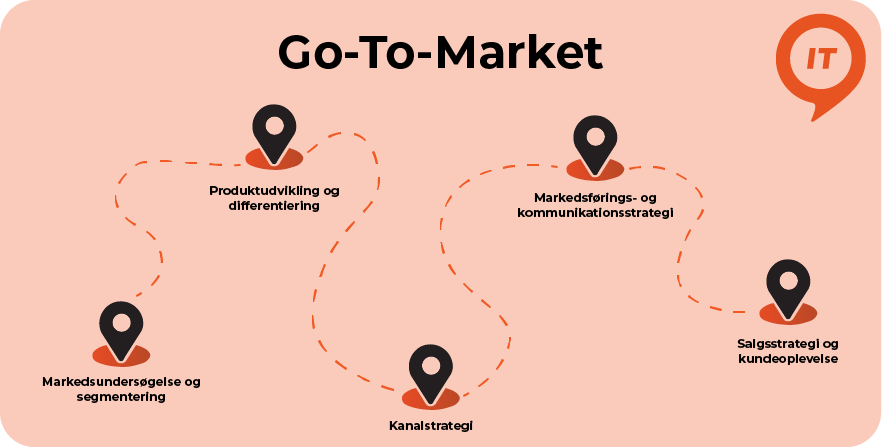IoT Go-To-Market Strategy (GTM)
We live in a world where technological advances are changing our everyday lives in countless ways. The Internet of Things (IoT) is one of the most revolutionary trends that has taken the industry by storm. With IoT, we can connect a wide range of devices and systems to the internet and achieve unprecedented opportunities for efficiency, monitoring and automation.
But developing an innovative IoT solution is just the beginning. Realizing the full potential of IoT technology requires a well-designed and well-thought-out Go-To-Market strategy. An IoT Go-To-Market strategy is about finding the most efficient way to bring your IoT solution to market and achieve success in the rapidly changing digital landscape.
Time to read: 5 minutes
Subject: IoT, Go-To-Market, Business case
Author: Villy Olsen, Iterator IT

What is a traditional GTM-strategy?
It is important to understand the basis of a traditional Go-To-Market strategy as it forms the foundation from which we can explore and adapt the strategy to the unique dynamics and complexities of the IoT market. A traditional Go-To-Market strategy is a well-defined plan that describes how a company will bring its product or service to market. It focuses on the necessary activities, resources and tactics to reach your target audience and achieve a successful launch and sustained growth.
A traditional GTM strategy usually involves the following elements:
Market research and segmentation: This involves analyzing the market and identifying target groups, needs, competitors and trends. By understanding customer segments and their preferences, the company can target its products or services more effectively and differentiate itself in the market.
Product development and differentiation: It's about creating a unique and differentiated product or service that stands out from the competition and delivers value to customers. This can include functionality, quality, price, design, user experience or other unique features.
Channel strategy: The company must choose the most appropriate distribution channels to reach its target audience. This can include direct sales, dealers, distributors, online platforms or a combination of multiple channels. The choice of channel depends on the nature of the product, the target audience and the competitive situation.
Marketing and communication strategy: An important part of the Go-To-Market strategy is to create awareness, interest and demand from the target audience. This can include advertising, PR activities, digital marketing campaigns, social media, content marketing and other communication efforts. It's important to develop a clear messaging strategy and choose the most effective channels to reach the target audience.
Sales strategy and customer experience: This area focuses on building a strong sales team that can execute the strategy and achieve sales targets. This involves identifying sales opportunities, building relationships with customers, handling negotiations, pricing and delivering an excellent customer experience to ensure customer satisfaction and repeat purchases.
A traditional Go-To-Market strategy can vary depending on the company's industry, product type and goals. But the overall goal is always to maximize product value, market share and revenue through an efficient and targeted approach to the market.
Traditional GTM strategy vs IoT GTM strategy
In many ways, an IoT GTM strategy is similar to a traditional GTM strategy. However, there are some focus areas to pay special attention to when moving from unconnected products/services to IoT products/services.
One area to pay particular attention to is the nature of the product. In a traditional GTM strategy, the product is often a physical product, whereas in an IoT GTM strategy, the product often involves a combination of physical devices, sensors, software, data analytics and cloud infrastructure. It's not just about delivering a physical device, but also about supporting the entire ecosystem that utilizes IoT technology. This means, at the same time, that you also need to be particularly keen on data management and interoperability. IoT solutions generate huge amounts of data and often involve multiple devices, platforms and systems that need to work together.
A technology-heavy product therefore makes the GTM strategy more complex both in the product development phase, but also in the ongoing delivery of the product/service. An important aspect of an IoT GTM strategy is also to take into account the ongoing development and innovation in the IoT field. Technology evolves rapidly, new standards and protocols emerge, and new application areas are continuously being discovered. Therefore, it is crucial for companies to be agile and flexible in their GTM approach in order to adapt and take advantage of the latest IoT trends and opportunities.

In a nutshell, an IoT GTM strategy is about adapting and extending traditional GTM principles to meet the unique challenges and opportunities associated with IoT solutions. By identifying and harnessing the potential of IoT technology, differentiating themselves in the market, creating value for customers and being aware of the evolving IoT landscape, companies can achieve a strong position and success in this ever-growing and dynamic market.
Identify your business case
Before you start building an IoT product and investing in infrastructure, it's crucial to identify your business case as a central part of your IoT GTM strategy. Too often, companies start with an "intent to connect" and focus primarily on the technical challenges of IoT, without thinking about how the technology will improve their business model - and possibly change it over time.
IoT is essentially a technical solution to a business problem. Therefore, it's crucial to build a business case for your IoT investment, assessing whether the savings or profits the solution will deliver are greater than the annual cost of implementation.

Unfortunately, it's a common mistake for many companies to misunderstand the real business problems they face, which can lead to the development of an IoT product that doesn't create real value. It's important not to simply feel the need to "IoT-ify" your products to make them more "modern". Whether you're selling to consumers or business decision-makers, it's crucial to find out if your audience is actually interested in the product features enabled by IoT. In other words, you need to start by understanding your buyers.
You need to study and validate your target audience and their needs before you decide to invest in IoT just because it seems exciting. IoT products only become economically viable when they continuously and repeatedly create value for your business and your customers.
So how can you make your revenue stream more predictable and stable? How can you build long-lasting relationships with your customers? An IoT strategy can not only solve specific problems, but also be a tool to transform your business value for the better.
By identifying your business case and validating customer needs, you can ensure that your IoT investment is targeted and creates real value for both your business and your customers. This will form the basis for building a strong and sustainable IoT GTM strategy.
Localize the value
An important part of identifying your business case is pinpointing where IoT can create value - and that can be for the buyer, the seller and sometimes even in between.
When it comes to IoT, value creation can be broad-based. It can include optimizing processes and workflows, reducing risks or costs, as well as introducing new revenue streams and increasing customer value. By uncovering and leveraging these potential value streams, you can maximize the benefits of implementing IoT solutions.
Here are two key areas where IoT typically creates value:
Optimization and efficiency: IoT provides the ability to collect and analyze large amounts of data from various devices and sensors. This opens up opportunities for process optimization, predictive maintenance and energy savings. By leveraging IoT technology's ability to monitor and analyze data in real-time, businesses can identify inefficiencies, reduce waste, optimize resource allocation and improve productivity.
Growth and increased customer value: IoT also opens up new ways to drive revenue and improve customer value. By collecting and analyzing data from IoT devices, companies can offer better customer service and tailored customer advice. This can improve the customer experience and increase customer loyalty. In addition, IoT solutions can create new business models and revenue streams, such as subscription-based services or differentiated product packages.
By identifying and focusing on these value creation areas, you can maximize the business benefit of implementing IoT solutions. It's important to understand how IoT can create value across different dimensions of your business and identify the tangible benefits that IoT can bring to your customers and your business.
If you are interested in reading more about the different use cases that can be achieved with IoT, click here to learn more about the different applications
Proof of Concept - a crucial part of the IoT GTM strategy
A crucial part of building a successful IoT Go-To-Market strategy is developing and demonstrating a Proof of Concept (PoC). PoC is an important milestone that allows you to validate your concept, test the functionality and gather valuable feedback before fully investing in development and marketing.
By focusing on PoC, you can minimize risks and costs while ensuring that your IoT product or service meets the actual needs of your customers. PoC allows you to test your idea in practice, demonstrate the concept and validate its viability.
At Iterator IT, we have extensive experience in helping companies develop and bring different types of IoT products and services to market. We understand the importance of putting ourselves in our customers' shoes and creating solutions that address their specific needs and challenges. By working with us, you can be sure to get a professional partner who will help you execute a successful PoC. We always work closely with our customers to understand their vision, identify key features and requirements, and then translate them into a practical solution. Our expertise in Go-To-Market strategy and our deep technical insight into IoT will ensure that your PoC is precisely aligned with your customers' needs and expectations.
We will ensure your PoC is carefully planned, developed and tested to deliver reliable results. Our goal is to help you reduce risks, validate your business case and be ready to bring your IoT solution to market with confidence and success.
If you are interested in learning more about IoT Go To Market strategies, please feel free to contact us either via our contact form here or call our CEO Casper at +45 31 39 05 69
